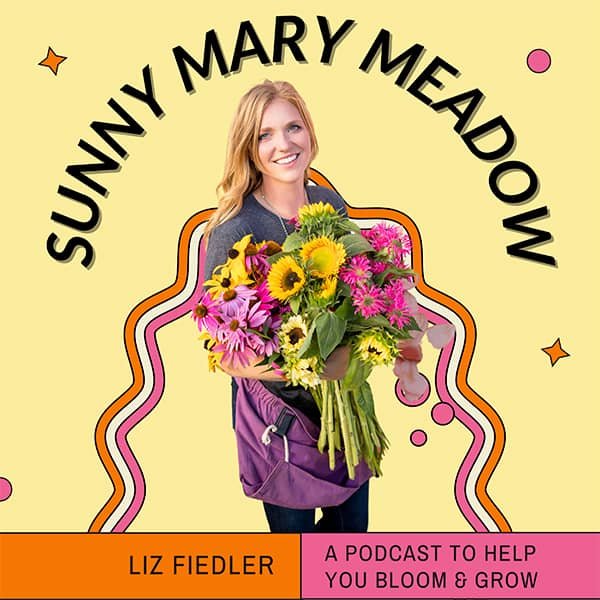
Welcome back to another Sunny Mary Meadow podcast/blog post. I am your host Liz Fiedler, and today we’re going to be talking about dahlias. I have two guests joining us today, Megan and Mallory from Blooming Creek Flower Farm. If you listened to the podcast already, you probably noticed that they sound sosimilar. Sooooo, to make it easier on the blog editor, after their intros, they will mostly be referred to as “The Twins” for their parts of the blog. They said to treat them as one, so we’re gonna roll with that. Haha!
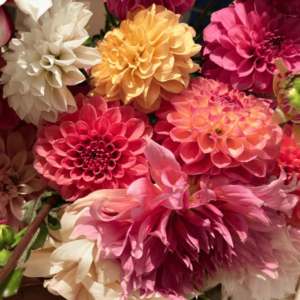
I’m gonna let them introduce themselves, but a little background is that we were friends in college, and now we live about 90 minutes apart. I have bought dahlias from them because their dahlias are so excellent. They are better at growing dahlias than me, which is why I wanted them to be guests on the podcast/blog. Who wants to go first? Who’s older?
One of “The Twins”: I am … Mallory.
Liz: You know, I don’t know if I expected that. I thought maybe Megan was older.
Mallory: I’m older by a minute, but whatever.
Liz: I would take credit. Okay, so Mallory, go ahead.
Mallory: Sure. Yep. So, my name is Mallory Thompson. I’m one of the twins here at Blooming Creek Flower Farm. We are in our third full year of flower farming. The farm is located at Megan’s house. I live just four miles to the east of her, so we do live very close in proximity as well, which is really handy. So, I can just buzz over as the need arises, but I work full-time as a life insurance underwriter. I have been married for about 10 years, and we have two girls, ages five and three. So, when I’m not busy flower farming, I do have a full-time job, and I keep up with my family and so forth, as well.
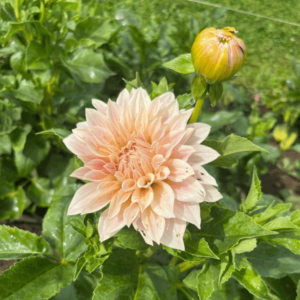
Megan: I’m Megan Fisher, the other half of Blooming Creek. As Mallory said, the farm is on our property. We’re located about eight miles or so south of DeGraf, MN. It is a small town west of Willmar. This is where we grew up, in fact, our parents live about 10 miles to the north of us. We’re connected to the community that we grew up in, and our kids will go to the school we attended. It feels good to be home. My husband, Michael, and I have been married for seven years here this August. His nickname is the “Farm Maintenance Manager,”and he helps us out a lot. We have two girls, Nora and Caroline, and have a baby boy on the way. So we’ll be busy with that this fall, as well. My full-time job outside of the flower farm is working at. I work for Dooley’s Petroleum in Willmar as a customer service rep and CSR manager. So that’s a little bit about me.
Liz: At the end, we’ll talk more about where they can find you guys, but I’ll say it now, too. They are Blooming Creek, and they’re on Instagram and Facebook.
So, we’re gonna just start at the very beginning with dahlias. I think we’re going to talk about planting them, fertilizing, weeding, trellising or staking, picking, vase life, using them in landscaping/pots (and what the difference is between that and growing them as cut flowers), and then dividing and storing. Anything you guys think we should add to that? Am I forgetting anything? Bugs. We’ve gotta talk about bugs. Super fun.
The Twins: But it’s a big part of it for sure.
Liz: Dahlias are a tuber, which is similar to a little potato. It’s a root. It’s not a bulb, it’s not a seed. You can plant them from seed, but you won’t get the same variety. It’ll be a mystery flower, essentially. So, you plant these tubers, and you have to make sure it has a viable eye, just like a potato when they start sprouting. So you have to make sure it has one of those. I’ll let one of you talk a little bit about how they’re perennials but not really in our area and zones.
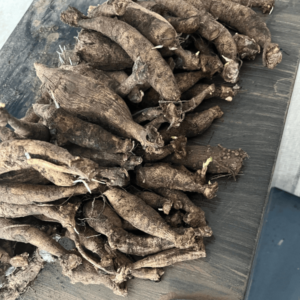
The Twins: So yes, tubers or dahlias in Minnesota are not a perennial. They need to be planted in the dirt in the spring. You plant them pretty early, but after the soil warms enough because they cannot tolerate any frost. So, we plant them usually mid-to-end of May. I think this year, it was the 20th of May or so. Then finally, once they’re sprouted, we pinch them back and watch them grow. We finally get the first blooms after pinching, usually by late July. So, it’s kind of a shorter growing season, but then from the first blooms through our first hard frost, they’ll have many, many booms. And they get super tall as long as you keep picking and keep pinching them. Some grow to be over like five feet tall. It’s so fun to see that.
Liz: So, I usually plant them about four-to-six inches deep, which I think is probably deeper than most people do. But it gets so windy because my meadow is wide open, so that’s how deep I go, and they do fine. I don’t know. How deep do you guys plant them?
The Twins: We plant them about four inches deep, as well, I’d say. Any less than that, and I feel like they start popping through the top of the soil.
Liz: Exactly. And then what about things like bone meal? Do you guys do that?
The Twins: We did try bone meal the very first year we grew more than a dozen. And the dog immediately dug them up.
Liz: Yes, my dog went after them, too. Merle dug them out because it smelled like bone or whatever.
The Twins: Yeah, we just don’t really see that it was that beneficial, and we’re not going to deal with it.

Producer Abbey: Can you guys explain what bone meal is?
Liz: So, it’s like, it’s calcium, right?
The Twins: It’s like a white, powdery fertilizer that you put first into the hole before you even put the tuber down. So you dig the hole, put the bone meal down, and then plant the tuber with it basically. So, before they’re even sprouted through the soil, the bone meal is just hanging out with the tubers. And then, as I said, it can be a nuisance for animals to dig it out. It’s good fertilizer because it’s made from animal waste.
Liz: Well, according to gardenerspath.com, bone meal is an organic fertilizer derived from … you guessed it, bones. Your meat bone waste from slaughterhouses undergoes a steaming process before being pulverized into granules of powder for use as a soil amendment. It’s rich in phosphorus. So that’s why our dogs go after it. I mean, I knew it was bone. So anyway, that’s fun. I haven’t used it since then. I don’t know, maybe I should. I feel like if you guys don’t do it, I’m not gonna do it. Because whatever you guys do with your dahlias, that’s what I need to do because your dahlias are great. So, I did pot some up – the ones I bought from you guys, actually. They have a tuber sale every spring, and I bought 15-20, something like that, from you guys, and then I potted them up ahead of time. So, they were a good eight inches tall when I transplanted them out, just to get a little bit of an early start. We’ll see … I don’t know. Some people do that. Like, I know there’s a flower farmer in Wisconsin, who pots up like 200 of them, but I just can’t keep up with it if I do that. I don’t remember the water them … it’s just not good.
The Twins: No, we’ve never really done the potting.
Liz: I mean, yeah, you get flowers an extra week or two earlier, but it’s a lot of work to do that stuff. You get them blooming an extra week or two earlier, and maybe you can sell more bouquets or whatever, but you have to take a half hour out of your day to water them all and check on them. Right now, I’m thinking, “Nope. No, thanks.”
When planting them, they can take up to like six weeks to come up for the stragglers. Some of them are up in three or four days, and some of them take a month or more. In fact, I gave up on them, and then I started digging them up just out of curiosity, and then I was like, “Oh, there it is. Oops.”

The Twins: Yeah, we found some of that as well.
Liz: And they catch up. They feel like they still all bloom at the same time. I don’t know. Maybe not, but they are within a close time period. It’s not like they bloom six weeks apart if they sprout late. So, that’s kind of planting.
So right now, mine are probably mostly between eight inches and 12 inches – depending on the variety. In fact, as of when we’re talking, I’ve got a few that are a couple of feet tall already that are budding that I missed pinching.
So then, let’s talk about pinching. Does one of you want to talk about that?
The Twins: Yeah, I was going to say the same thing, too, for height. Some of ours now is a little on the shorter side, some that were kind of slow to come up are maybe just in the six-to-eight-inch range. And others are pretty tall.
Basically, for pinching, you just pinch them back down so the buds and the first set of leaves are gone. That’s just gonna help encourage the plant to grow taller and branch out more which is ultimately just gonna lead to more flowers.
Liz: It also kind of makes the whole thing a little sturdier. And if you don’t pinch them, you get like a broomstick of a stem that’s enormous, so you have to pinch them.
The Twins: Yes, the stems get very thick otherwise.

Liz: Then do you guys ever have it when you pinch them, and it’s like a huge circle? Some people will cover that. I never ever have, and I’ve never had a problem. They say if rainwater gets into it, it can harm them. (Sarcastically) Well, first of all, it doesn’t rain here. So, whatever.
The Twins: Exactly. We don’t have that problem this year.
Liz: But do you guys ever do anything with that? I mean, there’s some flower farmers that I follow that say to put a pin over top or saran wrap, and my thoughts are, “Who has time to do that?” I don’t do anything ever.
The Twins: No, we don’t either. I know exactly what you mean, some of them, by the time they’ve grown and you pinch them, they’re as big as round as a nickel or a quarter already. But no, we never do anything with that. We just cut it off and let it be. We’ve never had a problem.
Liz: And I know some people will try to propagate from their pinchings. And I think that’s a big thing right now, but I’m just barely trying to stay ahead. I don’t need to grow my supply that much, and honestly, all my dahlias are pretty well mixed up. They were not labeled great this last year because I was moving into my house. We’re just glad I got them out of the ground. So, it’s gonna be a rainbow one more year. So, my luck, they’ll be the ugly ones that I had meant to throw away. Those will be the ones that I’d take the time to baby, and they probably wouldn’t even bloom in time, so then I wouldn’t even know what kind they were anyway. That’s kind of my theory on that – I’m not going to try to plant the pinchings.
The Twins: Yeah, no. It’s a good way to grow your stock like you said but it’s not worth it this time of year.
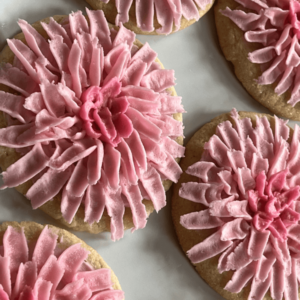
Liz: So, next, I want to talk about trellising. So, I think I did the same thing as you guys. T-posts with two levels of string around the edges so that they keep the outside ones from flopping over, and the middle ones will support each other. Right.
The Twins: Yeah, we did it that way our first year – we just kind of corralled them that way. Actually, even before that, we didn’t have as many, so we just bamboo-staked them individually, and that worked great. Got a few more the next year and did the corralling method. Then last year, we looked into doing what they call the “Florida Weave.” It is just twine again through T-posts, but instead of just straight rows of twine, they are X’d or criss-crossed through all the rows. So, it offers more support through the middle.
Liz: Nice. I should maybe look into some middle support. I see quite a few growers using netting … like the six-by-six netting, and I’m worried about that for them. Wouldn’t that be so messy? I just feel like it’d be really hard to harvest. Even for myself right now, with my snapdragons, I’m just cursing harvesting through the netting. I don’t want to do it.
The Twins: No, I feel that at the end of the season, too, like when you go to cut them all off it will be a mess. Cutting the stem at the bottom or towards the ground and taking all that foliage plus the net just seems like a mess.
Liz: Yeah, it seems like a mess. The first year that I grew them, I had like nine or 10 plants, and I used tomato cages. That’s what I had, and it worked well. Then maybe one or two I did bamboo stakes for, which is literally like a stick in the ground that you tie it to. But yeah, I used tomato cages.
The Twins: They just need to be supported.
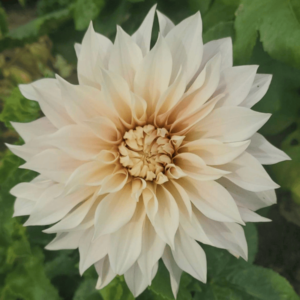
Liz: Yeah, exactly. Otherwise, they’ll just grow along the ground.
The Twins: And flop over. We have too much wind here for that.
Liz: So, let’s talk about fertilizing next.
The Twins: Yeah, we don’t actually do that much fertilizing. Our soil has seemed to work out really well. The only thing we use, or put down, when they’re about a foot tall or so, is the Dr. Earth Bud & Bloom Booster – it’s in a pink bag. You just sprinkle it like on the soil and kind of work it in with a hoe or like a Garden Weasel. So, you work it into the soil a little bit, water it, and then let it go. That’s all. It’s supposed to increase the amount of blooms you get per plant, I think, without being too high in nitrogen.
Liz: Nice. Yeah, I did spray some fish emulsion on mine two or three weeks ago. I don’t know if it helped. I sprayed it on my ranunculus once. I don’t know.
The Twins: I’ve always wanted to try it, but it’s so stinky.
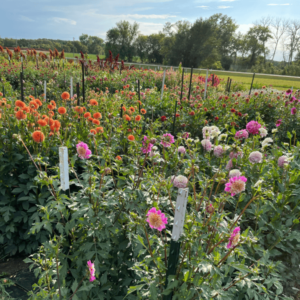
Liz: It’s so stinky. It smells. I honestly don’t know if I got a bad batch if that’s how it is, but it’s like this gooey stuff, and you shake it with water. I’m like, “Is it supposed to be solid? I don’t know. I thought it was liquid.” But anyway, it was just gross. It was just gross.
You guys don’t use landscape fabric for yours, do you?
The Twins: The only fabric we have out there is just between the rows. Otherwise, they’re planted just in the dirt.
Liz: Yep. Yep. That’s what I do, too. And honestly, where mine are planted, I get a lot of crabgrass coming through because it’s a new location, so that sucks. But after this year, it won’t be so bad. So that’s been crappy, but we just take the Hori Hori knife and go through it. It’s been manageable. I do put Preen (a preemergent) within them to try to keep stuff from sprouting, but that doesn’t stop crabgrass, so it doesn’t really take care of it all.
The Twins: Anything else it will be helpful for.
Liz: And the plants are big enough by now that it’s not bad. Like you just wait for the weeds to come through, and you pick them.
Alright, let’s talk about bugs if one of you wants to take the lead on that.
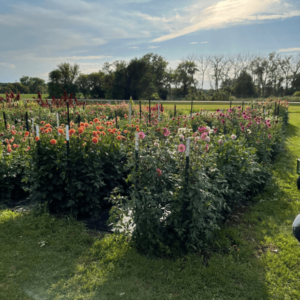
The Twins: Sure. So, pests, especially here in Minnesota, are the corn rootworm beetles. They love the dahlias. I’d say in about mid-August, you start to really see them start eating at the buds themselves before they’re even open. If you can manage it before you have too many plants, you can buy the little organza bags from a craft store or something and put them over the buds themselves before they open or before the bug has a chance to get into the middle of the bloom. Because once it gets in there, it’ll burrow and start ruining the flower, essentially. We counted tonight, and we have just about 200 individual plants, which would be way too many to bag.
So, that is one way to stop them, put the organza bags on each individual bloom. But like we said, when you have 200 plants, that’s like a million bags, there would be no way to keep up with it.
Liz: I think like some people just kind of wait it out and hope for the best, I don’t know.
The Twins: I feel like last year they were pretty bad. The last two years, we have not bagged them. We haven’t even attempted it because we’ve just had too many plants to do. So we actually have gone through it, and our dad has helped us spray them.
Liz: There’ll be people that will read this and be like, “don’t use chemicals,” or “don’t this or don’t that,” or “organic is best,” etc. And honestly, that’s up to the individual farmer to decide that, and they are tested. At the end of the day, it’s your crop, it’s your product, right? I mean, people don’t want holes in their flowers.
The Twins: We try to keep it to as minimal chemical use as possible all around. When it comes to preserving the flowers, and I’d say our best-selling flower, and we’re trying to make a profit on that specific crop, we’re not gonna risk it. We’re not going to have the whole field be eaten by the beetle.
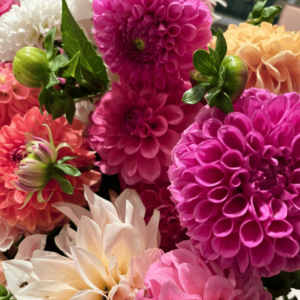
Liz: Yeah, exactly. They are a pest for a reason. I don’t know, I’ve never sprayed any of mine, but I’d have to make that decision at some point. I mean, I’ve thought about it, I just haven’t had the resources honestly, But at this point, I just haven’t had a problem. We’ll just keep hoping for the best. I mean, there are some flowers that you have to throw away, but for the most part, it’s been okay.
So, I guess the next part is the fun part – picking. Cut low. For most any flower that does branch, whether it’s zinnias or whatever, you cut it super low and then trim it up to get it ready in the bucket. For the most part, in the field, when we’re picking, whether it’s volunteers or my paid staff or me (most of the time it’s me … it’s not like I have a huge team), we cut it super low. Even if you sacrifice those side branches, don’t not cut it low because you’re hoping to get those secondary blooms. They’re not going to be as big anyway. It’s essentially pinching it again. So you keep cutting them low. That’s like my zinnias right now – it’s a similar thing. I have had a couple of people that are like, “Well, what about all those other blooms?” But it’s best for the plant to cut them low. We end up trimming it after cutting it low, so then I have them take it and kind of lay them on the ground and then cut them so that they’re all the same length. I started doing that this year because we’ve gotta save some time on making bouquets. It used to be just all these random different lengths in the bucket, and that doesn’t work. So, with dahlias, it’s the same thing as with the zinnias, you still have to cut them super low, even if you don’t need that long of a stem, you still need to cut it that low so that the plant keeps reaching up.
The Twins: It’s going to be more encouraging or beneficial for the plant in the long run. When people come to cut them, as you said, they’re kind of worried like, “Oh, should I really cut it that far down?” It’s like, “Yes, you need to cut that far down.”
Liz: You need to, and you have to. Those are the rules.
Do you guys do any hot water or anything like that?
The Twins: Nope. We just fill up our buckets from the hydrant, and away we go. We don’t do anything special with that.
Liz: Yeah, no, me neither. I cut my basil I cut into hot water, and I feel like maybe, is it Floret Flower says to use hot water for your dahlias? I don’t know, probably. I think I did my first year, but I didn’t notice any difference.
The Twins: They do okay either way.
Liz: Yeah. And I think their vase life is okay.
I think this is a good time to start talking about favorite varieties. I fell into the trap of buying what I liked, which is why I have an entire row of 100+ Café Au Lait dahlias. They’re really pretty, and they’re awesome, but they don’t last a long time. They only last four days. Most of my customers understand that after four days, just take that one out. But it’s really pretty, it’s really pretty while it’s there. But then there’ll be people that will be like, “Well, it only lasted a few days…” and I’m like, “I know that’s all they last.” So, that’s why I bought a bunch from you guys. I needed more ball dahlias.
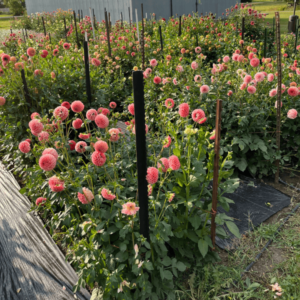
The Twins: Yep, they definitely have a longer vase life.
Liz: And I love the … I don’t know what you call them … kind of like wispy, stringy-looking dahlias. You know what I’m talking about?
The Twins: The cactus-style?
Liz: Yeah. I love those, but again, not in arrangements necessarily. Or I should say, not in bouquets. Like I say all the time, I do a lot of bouquets, not necessarily arrangements. You know, it’s focusing on the fresh flowers.
So, what are your favorite varieties if you had to pick? This is a loaded question … and maybe it’s different for both of you. But if you could only grow five dahlias for your cut flower farm … so not based on looks, not based on how it looks in landscaping, but like producers.
The Twins: Each of us? Or the two of us holistically?
Liz: Whatever …
Megan: So, this is Megan here, I am actually just even more partial to, like, the ball types anyway. They’re my favorite. So, I would say if I did pick five, I would go with Caitlin’s Joy and Jowey Winnie … they look really similar. They’re both pink ball types. I also love … thinking productivity-wise… KA Rosie Jo is in my top three, Snoho Doris, and let’s round ‘er out with Larks Ebbe.
Liz: I don’t know if I know that one. Is that a yellow one?
The Twins: Yeah, it’s more of a water lily style. Not as much of a ball but it has a really good vase life and it’s an amazing tuber producer.
Liz: Nice. Nice. Well, I know I bought three of those from you guys for sure – the Caitlin’s Joy, the Jowey Winnie, and I think the Snoho Doris. I do love Ivanetti. It’s dark, so it’s pretty. People seem to like that one.
The Twins: It’s a great one for fall because it’s a burgundy color. Yeah,
Liz: Yeah. I did some Cornell Bronze. I bought new ones this year.
Mallory: That’s one of my top three.
Liz: Yep. Yep. And then of course my Café Au Laits. But again, they’re great for weddings. They’re great for you know, event work, but I don’t really do a lot of those at this point. So I don’t know.
The Twins: We started off also growing what we liked, so we did have quite a few dinner plate styles, like the Café Au Lait, but just found that the vase life wasn’t great for making bouquets, and ultimately, you want to give a good flower to the customer. So, we really have transitioned a lot of them to the ball types, I’d say.
Mallory: Based on vase life, I would say I agree with Cornell Bronze, Ivanetti, and probably Daydreamer. Any of the smaller ball ones.
Liz: And you guys don’t have a walk-in cooler, do you?
The Twins: No, just stand up cooler—some day.
Liz: Yeah, and most people don’t. I just have one because there used to be a butcher shop here. If you’re wondering about that, if you’re new to the blog, go back and read one of the early posts about my butcher shop cooler. Anyway … how do you guys store them in the cooler then? Like overnight? Or do you just use them on the same day? Or what do you guys do?
The Twins: Most often, we’re picking for our bouquet subscriptions, usually just the night before, especially for dahlias. So, I’d say after we are picking them, we’re cutting them down to size right away for our mason jars and putting them in the fridge basically just overnight. So we really are only storing them short term.
Liz: So, to go along with that … this is kind of moving from the conversation of dahlias, but isn’t it kind of weird to you when they always say to “let them rest?” Like, can’t I let them rest in the vase?
The Twins: Yeah, right.
Liz: That’s what I don’t really get. They’re like, “… before you arrange them.” I feel like, well, if I cut it, and I put it directly in the vase, isn’t it soaking up water? I don’t know. Do you guys know what I’m saying? Although I have found with things like my celosia, I don’t touch it for a little while. Give it a good three or four hours before you start working with it.
But I don’t know about the dahlias. I feel like you cut it down to size right away, and then you put it in water.
The Twins: We haven’t noticed anything like you said, if rest-time or leaving it in a bucket in the garage or in the shed or whatever, doesn’t really seem to matter in the quality of the flower.
Liz: I don’t know, there’s a lot of flower farmers that I follow for hacks and whatever that talks about it. I have a really nice shade tree down by my flowers, and I’ve thought like, “Hey, let’s just bring 50 jars down there to make the bouquets in the field as I’m picking them.” But now I have a space for making bouquets, and it’s perfect, so I don’t need that. But before I had that, I thought about it. But then I feel like if you get pulled away because of a kid or something, all of a sudden, your flowers have been sitting outside for two hours or even longer. I guess it’s not a one size fits all to me. So, you guys pick them, bring them inside right away, make the arrangements and then put them in the cooler.
Okay, so then the next thing I want to talk about is growing dahlias as a hobby grower, not as a cut flower farmer where you’re not going off productivity. The ones that you see at most greenhouses are going to be a stunted variety.
The Twins: Or they’re blooming in April.
Liz: Yeah, exactly. And they’re blooming super early, and they’re in pots, and most people leave them in pots. You can’t really use those for cut flowers. They’re not gonna get tall. They’re genetically modified to be short.
The Twins: Yep. And the stems are so thin, and I feel like the flowers are so frail. Yeah, it’s not a cut flower type.
Liz: Yeah, like it’s a dahlia, but not really going to work the way we’re using them. But you know, some people are intimidated by them. You guys have an awesome tuber sale. I definitely want to add a tuber sale of my own in the future because it is obviously very profitable. I would love to offer it to my customers … local ones. You guys do shipping, but that makes me so nervous, but it works. And the ones you guys sent me were here the next day, which was so cool.
The Twins: It was really fast.
Liz: People are like, “Well, I’m so nervous about dividing them.” And we’ll talk about that in a little bit, but honestly, but what’s the worst that could happen? Just treat it as an annual. You spend 10 bucks on a tuber, just like you would on a potted plant somewhere else. The worst that can happen is you let it die off. If you want to buy a Café Au Lait dahlia from me, I’ll teach you how to do it. Stick it in the ground. And then in the fall, if you don’t want to divide it up, or you’re nervous about storing it or whatever, just let it die. Buy a new one. It’s $10.
The Twins: Yeah, we had some customers last year who bought tubers, and then they admitted they didn’t dig them up. They just let them freeze in the ground, and they bought more this year.
Liz: Yes, exactly. And that’s where it’s like, treat it as an annual. You can totally do that. I mean, I spent $9 on a sandwich at Erbert & Gerbert’s today because I was in a hurry. Or you get a meal at Jimmy John’s, and it’s $19. But then people complain that my bouquets are too expensive. It’s like, “I’m sorry, but life is expensive.”
Let’s talk about what you guys do in the fall before the last frost, try to label them.
The Twins: Yes, yeah. We said last year that we’re going to try to label them earlier this year. Because last year, we we’re on our hands and knees when the plants were four feet tall or whatever, and it’s like sorting through a jungle trying to wrap the tape around the bottom. So this year, we’re going to try to get them labeled a little earlier. Yeah, that was a mess.
Liz: Yeah, I definitely need to do that. That’s an August project for sure. Mid-August.
The Twins: As soon as we get our first flowers on the plants, they’re getting the label.
Liz: Yep, yep. Yeah, because it’s exciting. But cut them and put a label on it. I will probably be texting you guys pictures of them because guess who didn’t label anything … it’ll be like, “Anyone know what this is?” So, we have a group text called Flower Farmer Friends, and there’s a bunch of us in it, and that’s gonna be what that is now … a dahlia labeling group. Sorry about your notifications. So yeah, label them. What do you guys use? I’m assuming you use a little plastic ….
The Twins: We have used the plastic little tags that we’ve just ordered off Amazon before, but we find that they break so easily. If the weather gets cold or something, they just snap. So then you’re kind of lost with that variety. After they’re done flowering, you can’t tell which one was which. So, then last year, we used colored ribbon tape, and you can write on it with Sharpie or a garden marker, and it sticks just fine. That’s easier just to tie around the big stem on the bottom.
Liz: How many varieties do you think you have?
The Twins: We have 57.
Liz: Wooooow. Okay, I’ve probably got like 20 varieties, but I have 490 plants. No 410 plants. But again, a lot of Café Au Laits … like probably almost 200 Café Au Laits because of my own wedding this year. I divided them a ton because I want them for my wedding in October. Now watch, we’ll get a September 15 freeze, and I won’t have them.
The Twins: Don’t say that! Yeah, last year, we did have a freeze around September 20.
Liz: Yeah, yeah. So, we’ll see.
The Twins: It’s called flagging tape, like the bright fluorescent pink flagging tape. So it’s easy to spot.
Liz: Nice, I’ll have to try that.
To be continued …
We were having way too much fun, and there was way too much good information being shared with Mallory and Megan, so we’re gonna divide this episode/blog post in half. So next week, you will get part two of our time with Mallory and Megan from Blooming Creek. Make sure you’re subscribed so you get the notification when the next episode drops.
Additional Note from Liz: Hey, everyone! I want to talk quickly about my course that I’m launching this fall, Peddling Perishable Products. Essentially, if you like the episodes where I tell you how to grow the flowers, I really think you’re gonna like the episodes where I tell you how to sell the flowers. Ultimately, I tried creating some podcast episodes talking about how I do things, and it just felt incomplete, and I really want to make a difference. I want to make it easier on you, and I don’t want you to find out how to do things the hard way.
If you want more information on how to sell your flowers and turn them into a comprehensive business, go HERE and sign up for a Calendly call. I promise it’s not intimidating. It’s 15 minutes where I’m going to tell you the stats on my sales, and I’m going to ultimately give you information on the course. If, at the end of the phone call, the answer is no or not yet, I promise no hard feelings. I just really, really want to help you turn your flower hobby into a successful business if that’s what you want to do. Again, no hard feelings, just sign up on the Calendly link. Thanks!
Thanks for reading the Sunny Mary Meadow blog. If you like what you’re reading, please subscribe to the podcast and rate us. You can also find us on Instagram, Pinterest, and Facebook.
You can subscribe to our email newsletter below. We love to hear any podcast-related feedback at our email podcast@sunnymarymeadow.com, and all other inquiries can be sent to liz@sunnymarymeadow.com.

